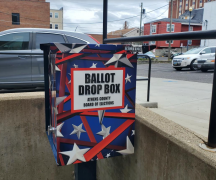By David C. Barker| Sam Fulwood III
Ohio Capital Journal/The Conversation
Most political analysts define “swing voters” as those who swing their support from one party to the other between election cycles – determining winners and losers in the process.
According to this conventional wisdom, the “swingiest” voters are working-class whites in the Midwest, who supposedly hold the keys to the White House.
Meanwhile, by contrast, pundits often portray Black Americans as an undifferentiated mass – loyal Democrat-supporting foot soldiers who will execute their mission for The Team on Tuesday as long as some preacher provides the right marching orders on Sunday.
If these depictions have not already expired, they are certainly growing stale. Having studied electoral trends for decades, we can tell you that those undecided voters of the past are an endangered species – in the Midwest and elsewhere. These days, the only choice that most Americans make – indeed, the choice that typically “swings” the election outcome — is whether to vote at all.
That brings us to the characterization of Black Americans as Democratic loyalists.
Our new survey of 1,215 African Americans in battleground states – Wisconsin, Pennsylvania, Michigan, Florida, North Carolina and Georgia – reveals that while those over 60 remain among the most reliable of Democratic voters, and those between 40-59 are still pretty locked in as well, those under 30 (whom we oversampled to comprise half of our sample) are anything but.
Not sold on Biden
Only 47% of those Black Americans under 30 years old that we surveyed plan to vote for the presumed Democratic presidential nominee, Joe Biden. That’s roughly the same percentage who have anything positive to say when asked what “one or two words come to mind” about the former vice president.
Cathy Cohen, a professor of political science at the University of Chicago who studies Black youths’ political views, summed up this attitude in a recent podcast: “They’ve seen the election of Black mayors, they’ve seen the election of the first Black president, and they’ve also seen that their lives have not changed.”
Not sold on voting
These young Black Americans may well sit things out in November, just as many of them did in 2016 when their behavior swung that election to Trump as much as anything else did.
In our poll, 31% of Black Americans under 30 say they probably won’t vote in this election. That may sound pretty good, given the average U.S. voter turnout of around 60% in recent elections.
But survey respondents of all stripes tend to wildly overestimate their intention to vote. Indeed, about half of our Black survey respondents under 30 say they don’t often vote because it “doesn’t make a difference,” providing a somewhat more realistic estimate of the percentage who will probably just stay home – and not search for a stamp to mail in their ballot, either.
And that number does not even take into account the turnout-depressing effects of voter suppression efforts taking place across the country, the pandemic or the heavy distrust of mail-in voting that young Black people tend to express. Only 64% of young people in our sample say they trust the state to report their vote accurately, and only 30% say they plan to take advantage of mail-in voting.
Not sold on the Democratic Party
Such cynicism on the part of young Black Americans is reflected in the lukewarm feelings they tend to have toward the Democratic Party more generally.
Only 47% of them say that the party is welcoming to Black Americans, and only 43% say they trust Democrats in Congress to do what’s best for the Black community. Perhaps most strikingly, unlike their older counterparts, only half of those under 30 view the Democrats as any better than the Republicans on these scores.
[Deep knowledge, daily. Sign up for The Conversation’s newsletter.]
In both the survey responses and in the focus groups we conducted of young Black Americans in these same states, we heard repeated frustration toward what they view as a Democratic Party that expects their vote but doesn’t really do anything to deserve it other than claim to be “less racist” than the alternative.
As one of our focus group respondents put it, “I think at the end of the day, they all have the same agenda.”
In short, it appears that for Black America, the future is not necessarily “blue.” Electorally speaking, it is not necessarily anything at all. Moving forward, young Black Americans may be the real “swing voters” in the only way that term really makes much sense anymore.
David C. Barker, Professor of Government and Director of the Center for Congressional and Presidential Studies, American University School of Public Affairs and Sam Fulwood III, Fellow, Center for Congressional and Presidential Studies, American University
This article is republished from The Conversation under a Creative Commons license. Read the original article.
***
DeWine says state doesn’t have money to supplement unemployment, but silent on more federal dollars to states
Ohio Gov. Mike DeWine on Tuesday said the state doesn’t have the money to supplement unemployment benefits. But he didn’t speak up for a plan to send state and local governments additional money.
In a press conference, DeWine praised a move by the Trump administration to use executive orders to replace a $600-a-week federal supplement to state unemployment insurance that expired at the end of July with a $300 weekly payment.
“I think what the president did was the right thing,” DeWine said. “The president was looking at a stalemate. He wanted to move the ball, maybe get people to negotiate more, but also try to do a positive thing.” READ MORE
COVID-19 cases in children rise, educators still begging for financial back-to-school help
As data shows rising numbers of children contracting COVID-19, school districts are still begging for funding to keep students and staff safe.
One of the state’s teacher’s unions said school districts can’t be expected to live up to the standard needed to prevent COVID-19 spread in schools if they don’t have the proper resources.
“All students are going to be learning in a different environment than we’re used to, and all students are continuing to live in a state and in a country, in a local community where we still have a pandemic going on,” said Scott DiMauro, president of the Ohio Education Association, during a Tuesday press conference with progressive think tank Policy Matters.
DiMauro is also concerned about new data from the American Academy of Pediatrics and the Children’s Hospital Association, showing a 90% increase in COVID-19 cases among children in the last month, and 97,000 cases nationwide among children. READ MORE
Ohio State to launch mandatory COVID-19 testing program for students
Ohio’s largest university began its early, voluntary phase last week of an ambitious COVID-19 surveillance plan for the looming pandemic semester.
But come Aug. 25, if randomly selected Ohio State University students opt out of swabs up their noses, they can expect a university order to quarantine, a referral to Student Conduct for non-compliance, and a student ID card that won’t open any OSU door but their dorms.
The plan goes like this: Before fall classes a “random sample” of OSU students will be tested for the new coronavirus, which can range in symptoms from nonexistent, to mild, to serious to lethal (rare in the collegiate age range).
Those results will give university administrators a baseline prevalence — the proportion of students administrators would expect to carry the new coronavirus at a given time in a batch of tests.
Then, OSU will test 300 randomly selected students every weekday (100 on Saturdays) for COVID-19, free of charge, regardless of exposure or symptoms to the virus. READ MORE





